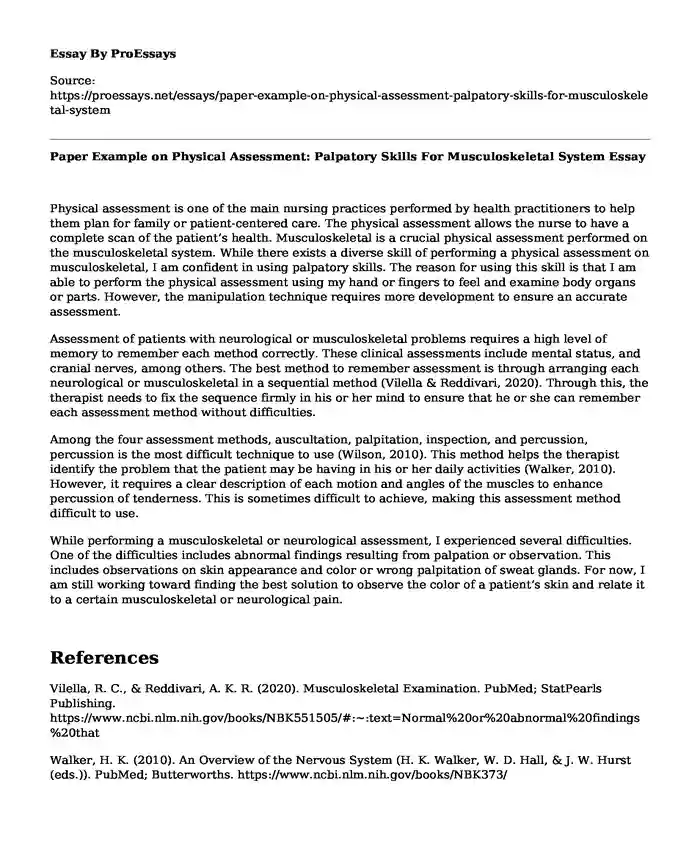Physical assessment is one of the main nursing practices performed by health practitioners to help them plan for family or patient-centered care. The physical assessment allows the nurse to have a complete scan of the patient’s health. Musculoskeletal is a crucial physical assessment performed on the musculoskeletal system. While there exists a diverse skill of performing a physical assessment on musculoskeletal, I am confident in using palpatory skills. The reason for using this skill is that I am able to perform the physical assessment using my hand or fingers to feel and examine body organs or parts. However, the manipulation technique requires more development to ensure an accurate assessment.
Assessment of patients with neurological or musculoskeletal problems requires a high level of memory to remember each method correctly. These clinical assessments include mental status, and cranial nerves, among others. The best method to remember assessment is through arranging each neurological or musculoskeletal in a sequential method (Vilella & Reddivari, 2020). Through this, the therapist needs to fix the sequence firmly in his or her mind to ensure that he or she can remember each assessment method without difficulties.
Among the four assessment methods, auscultation, palpitation, inspection, and percussion, percussion is the most difficult technique to use (Wilson, 2010). This method helps the therapist identify the problem that the patient may be having in his or her daily activities (Walker, 2010). However, it requires a clear description of each motion and angles of the muscles to enhance percussion of tenderness. This is sometimes difficult to achieve, making this assessment method difficult to use.
While performing a musculoskeletal or neurological assessment, I experienced several difficulties. One of the difficulties includes abnormal findings resulting from palpation or observation. This includes observations on skin appearance and color or wrong palpitation of sweat glands. For now, I am still working toward finding the best solution to observe the color of a patient’s skin and relate it to a certain musculoskeletal or neurological pain.
References
Vilella, R. C., & Reddivari, A. K. R. (2020). Musculoskeletal Examination. PubMed; StatPearls Publishing. https://www.ncbi.nlm.nih.gov/books/NBK551505/#:~:text=Normal%20or%20abnormal%20findings%20that
Walker, H. K. (2010). An Overview of the Nervous System (H. K. Walker, W. D. Hall, & J. W. Hurst (eds.)). PubMed; Butterworths. https://www.ncbi.nlm.nih.gov/books/NBK373/
Wilson, C. H. (2010). The Musculoskeletal Examination (H. K. Walker, W. D. Hall, & J. W. Hurst (eds.)). PubMed; Butterworths. https://www.ncbi.nlm.nih.gov/books/NBK272/#:~:text=To%20perform%20an%20examination%20of
Cite this page
Paper Example on Physical Assessment: Palpatory Skills For Musculoskeletal System. (2023, Nov 18). Retrieved from https://proessays.net/essays/paper-example-on-physical-assessment-palpatory-skills-for-musculoskeletal-system
If you are the original author of this essay and no longer wish to have it published on the ProEssays website, please click below to request its removal:
- Statistics on Unnatural Causes in Sickness and in Wealth
- Series of Events that Occurred During SARS II Paper Example
- Essay on Staff Burnout & Compassion Fatigue: Study at Heartland Behavioral Healthcare
- Case Study: Acute Pain and Work: Riley's Struggle in the Hospital
- Essay Example on Comparing RN & LPN: Differences in Qualification & Duties
- Essay Example on Tai Chi: Moving Meditation for Health Benefits
- Paper Sample on Exploring Social Determinants of Health in Botswana







